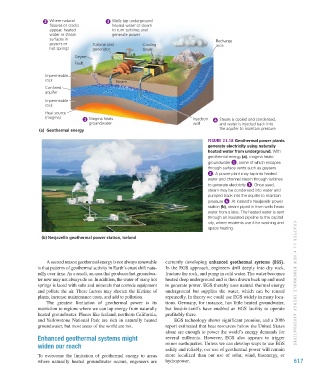Page 618 - Environment: The Science Behind the Stories
P. 618
2 Where natural 3 Wells tap underground
fissures or cracks heated water or steam
appear, heated to turn turbines and
water or steam generate power
surfaces in Recharge
geysers or Turbine and Cooling area
hot springs generator tower
Geyser
Fault
Impermeable
rock Steam
Confined
aquifer
Impermeable
rock
Heat source
(magma) 1 Magma heats Injection 4 Steam is cooled and condensed,
groundwater well and water is injected back into
(a) Geothermal energy the aquifer to maintain pressure
Figure 21.18 Geothermal power plants
generate electricity using naturally
heated water from underground. With
geothermal energy (a), magma heats
groundwater 1 , some of which escapes
through surface vents such as geysers
2 . A power plant may tap into heated
water and channel steam through turbines
to generate electricity 3 . Once used,
steam may be condensed into water and
pumped back into the aquifer to maintain
pressure 4 . At Iceland’s Nesjavellir power
station (b), steam piped in from wells heats
water from a lake. The heated water is sent
through an insulated pipeline to the capital
city, where residents use it for washing and
space heating.
(b) Nesjavellir geothermal power station, Iceland
A second reason geothermal energy is not always renewable currently developing enhanced geothermal systems (EGs).
is that patterns of geothermal activity in Earth’s crust shift natu- In the EGS approach, engineers drill deeply into dry rock,
rally over time. As a result, an area that produces hot groundwa- fracture the rock, and pump in cold water. The water becomes
ter now may not always do so. In addition, the water of many hot heated deep underground and is then drawn back up and used
springs is laced with salts and minerals that corrode equipment to generate power. EGS thereby uses natural thermal energy CHAPTER 21 • N E w R ENE wA bl E E NER gy AlTERN AT iv E s
and pollute the air. These factors may shorten the lifetime of underground but supplies the water, which can be reused
plants, increase maintenance costs, and add to pollution. repeatedly. In theory we could use EGS widely in many loca-
The greatest limitation of geothermal power is its tions. Germany, for instance, has little heated groundwater,
restriction to regions where we can tap energy from naturally but feed-in-tariffs have enabled an EGS facility to operate
heated groundwater. Places like Iceland, northern California, profitably there.
and Yellowstone National Park are rich in naturally heated EGS technology shows significant promise, and a 2006
groundwater, but most areas of the world are not. report estimated that heat resources below the United States
alone are enough to power the world’s energy demands for
Enhanced geothermal systems might several millennia. However, EGS also appears to trigger
widen our reach minor earthquakes. Unless we can develop ways to use EGS
safely and reliably, our use of geothermal power will remain
To overcome the limitation of geothermal energy to areas more localized than our use of solar, wind, bioenergy, or
where naturally heated groundwater occurs, engineers are hydropower. 617
M21_WITH7428_05_SE_C21.indd 617 12/12/14 4:29 PM

